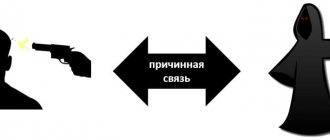A special subject of a crime in criminal law is a person who has special characteristics, the presence of which creates appropriate liability under a certain article.
The regulation and form of criminal acts have their own specifics. A special subject can be special or general; this is indicated in the provisions of the main regulations and the Criminal Code of the Russian Federation. This area of these legal relations has its own types of crimes and differences.
Before analyzing the main features of a special subject, it is necessary to consider the specifics of the criminal legal framework, which consists of a system of norms governing the determination of punishment and social relations in the field of unlawful acts.
For a clear presentation of the criminal area, there is a section characterizing the subject and the position of the criminal.
Today in criminal law and jurisprudence the main problem is establishing the crime of the subject and the sanity of the suspect.
Examples
There is such an additional object as the interests of justice.
They suffer not only in the case of a criminal act against justice, for example, in the form of contempt of court, but also in a large number of cases if the criminal act is committed after the court decision has entered into legal force. This is what it looks like:
- For example, there is such a composition, art. 177 (malicious evasion of payment of accounts payable). Accounts payable are debts owed by one party to another under a contract. This composition is in crimes against economic activity. It is emphasized that the interests of creditors are the main object. Due to the fact that non-payment of a debt occurs after a court decision has already been made in favor of the creditor, the debtor is found guilty of non-payment and is subject to payment obligations. This violates not only the interests of the creditor, who does not receive his money, but also the interests of justice, who has wasted certain judicial resources, time, and the like. Moreover, a binding court decision was made that is not being implemented. Such evasion, seemingly similar to a civil offense, is already a judicial matter.
- Malicious evasion of payment of alimony according to the report of the bailiff of the executor will be recognized as a crime, qualified under Article 157 of the Criminal Code of the Russian Federation, only if it is committed after a legal court decision has entered into force that alimony must be paid. Thus, the additional object suffers if it is directly named in the article, and at the same time is protected by this composition, in a sense, incidentally.
- An example can also be illegal actions committed in the field of land relations, which are the main object, meanwhile, when committing this lawlessness, other additional ones suffer, which include life, human health, and the environmental sphere.
In the chapter “Crimes against justice” there is an article where the interests of justice, accordingly, are the main object. It is noteworthy that if these interests were an additional object in the previously given examples of compositions, here it is the main one. But it is obvious that when an investigator or interrogator unlawfully releases a guilty person from liability, quite significant damage is caused to the interests of the victim. And it is they (interests) that are an optional object.
This type cannot be prescribed in the law, since not every criminal act has a victim, but for the court, when proceedings are underway under the article on illegal exemption from liability, this is important, since the judge needs to understand who else was harmed as a result of the crime. criminal act. That is, in the interests of the victim, the optional object influences the punishment, among other things.
Criminal law is a complex but very important branch. Its knowledge is of key importance in the life of society and the individual
The destinies and lives of people often depend on the court decision taken to impose punishment.
The theory of the object of crime is not only necessary, but very interesting and relevant science. If you want to study it more deeply, know the specifics of this subject, or if you need to replenish your existing knowledge of criminal law, the tests for studying criminal law presented on many legal websites will be useful for your studies.
Special subject
The Criminal Code of the Russian Federation has created an understanding that a special subject of a crime in criminal law is a person who has general and special characteristics of an act that is serious for society. In any specific incident, such entities are endowed with legal responsibility, and also receive punishment for carrying out an unlawful act.
The characteristics of a special subject are reflected in Art. 263, 275 of the Criminal Code of the Russian Federation
It is important that the absence of the characteristic features of the subject, which are provided for in a certain article, excludes criminal liability under this article.
Minor citizens will not be able to be subjects of an offense. A standard is put forward as a humanistic principle according to which a person who has not reached the age of majority and has psychological problems cannot be involved as a special subject, regardless of age.
In criminal law, a necessary condition for the use of sanctions is the ability of the offender to be aware of and control his behavior.
Optional features of a special subject can be expressed in several meanings:
- Signs of composition according to the Constitution (Article 275 of the Criminal Code of Russia).
- Signs according to classification (part 2, article 150 of the Criminal Code of Russia).
- Circumstances that soften or make sanctions more severe (clause “m”, Article 63 of the Criminal Code of Russia).
In order to understand what this category is, you need to look at the standards. A careful study of them shows that specific offenses are structured in a special way.
Not every citizen can be held responsible for committing criminal acts, but only those who have specialized characteristics.
A special subject in criminal law should be defined according to the following classifications with the definition of articles:
- Citizenship of a person (Article 275, 276 of the Criminal Code of Russia).
- Demography (Article 131 of the Criminal Code of Russia).
- Family and kinship relations (Article 156, 157 of the Criminal Code of Russia).
- Position (Article 285, 290 of the Criminal Code of Russia).
- Profession (Article 124, 143 of the Criminal Code of Russia).
- Attitude to military service (Article 328, 331 of the Criminal Code of Russia).
It is also worth saying that the definition and types of special subjects of the offense are interconnected units. The correct understanding of this scientific thesis hides the principles of its systematization specifically into small components.
Analysis of the concept of a special subject
Legal scholars note that the concept of a special subject has not been fully developed. A common opinion has been formed only regarding the fact that a special subject is a person endowed with characteristic features along with general characteristics.
The most important characteristic of any subject of a crime is his sanity. Therefore, it is important to understand the differences between medical and legal criteria for insanity.
Legal criteria underlie the court's assessment of a subject, and medical criteria reveal the reasons for a given person's insanity. However, such reasons cannot always relieve a person from responsibility for the crime committed, since the court assesses the degree of sanity only at the time of the commission of the unlawful act.
Some crimes committed by special subjects are especially dangerous for society precisely because their subjects have special traits. In particular, the recipient of a bribe can only be an employee of a government agency. His actions disrupt the work of a government agency, which is dangerous for the entire system of public values.
Dangerous actions for society committed by an official are specified in Article 30 of the Criminal Code of the Russian Federation.
Types of special subject of a criminal act
At the moment, the following signs can be identified:
- Characteristic features of the subject's status. The list of these traits indicates how a particular citizen communicates with government agencies. Such a block includes such features as: position in government bodies, occupation, position in relation to the law, powers associated with the official duties held, status as a participant in court proceedings, work in the field of medicine and much more.
- Characteristics of a person according to socialized, legal, psychological and physical properties. These include the gender, age of an individual citizen, and his medical indications.
- In order to classify many crimes, it is necessary to take into account the characteristic features of the role of the tasks performed during the commission of criminal acts. In this situation, the classification of subjects occurs through the analysis of their participation in each act that is dangerous to society. Based on this, it is worth highlighting the following types of subjects: a person who performs organizational functions, a leader and a participating citizen.
The differences between subjects predetermine a huge role not only for criminal and legal scientific orientation, but also for the practice of law enforcement agencies and courts. The development of legislation relating to the Criminal Code of the Russian Federation has at all times been accompanied by an established trend towards the growth of compositions with specialized criteria for subjects. The Working Code contains almost half of such articles. By understanding the role of the citizen, many legal issues can be resolved. For example, the responsibility of a special subject of a criminal act.
Socially dangerous actions are carried out by certain citizens. Any situation where a crime is committed has its own personal traits, including those that are considered to be the characteristics of the citizen guilty of this action.
Any personality has specific characteristics that make up its individuality. The main significant characteristics of each criminal are the understanding of what they have done and the achievement of a specific age. They determine the scientific understanding of the subject of a dangerous action.
The concept of a special subject
In the theory of criminal law, there is no consensus on the definition of a special subject. Yu. V. Tarasova summarizes the opinions of specialists on this issue [1]:
“Some scientists call a special subject a person who, along with the general characteristics of the subject, also has additional qualities (BC Orlov, AM Lazarev, G. N. Borzenkov). Others speak of a special subject as a person who has specific characteristics specified in the disposition of the article (N. S. Leikina, N. P. Grabovskaya, V. A. Vladimirov, G. A. Levitsky). Still others understand by a special subject persons who, in addition to the necessary signs of the subject of a crime (reaching a certain age, sanity), must also have special signs, determined by their activities or the nature of the duties assigned to them, by virtue of which only they can commit this crime (Sh. S. Rashkovskaya, R. Orymbaev)".
S. A. Semenov notes that the specificity of a crime with a special subject is such that “harm to social relations (the object of the crime) is caused from within by one of the subjects of the legal relationship, who is also the subject of the crime.”
The concept of the subject of a crime
The subject of a crime can be a natural, sane person who has reached the age established by law at which criminal liability begins.
From this definition follow the characteristics of the subject of the crime:
1. The subject of a crime is always an individual, and not legal entities, animals, objects and things, although their actions may cause harm to health or property.
2. A sane person is only a sane person, whose mental activity is not impaired, who is capable of realizing the social danger of his actions and managing them.
3. Age – according to Art. 20 of the Criminal Code of the Russian Federation, a person who has reached the age of 16 at the time of committing a crime is subject to criminal liability, and Part 2 of Art. 20 of the Criminal Code of the Russian Federation provides for specific elements of crimes, criminal liability for the commission of which begins at the age of 14.
Types and examples of crime objects
The scheme of objects of crime in the science of criminal law is divided both vertically and horizontally. The vertical hierarchy is represented by four types of objects.
General
The general object is a purely scientific concept that does not have direct significance for practice, but gives a general understanding, for example, what is the difference between an offense and a criminal violation, when an offense is considered an administrative violation, and in what cases - judicially punishable.
Generic
The general object is divided into types. A special part of the Criminal Code is built on the principle of dividing all offenses into sections and chapters. The section corresponds to the generic type of the crime object. It contains a group of similar relationships protected by one section.
These may include:
- Personality.
- Own.
- Moral.
- Human security, peace.
So, according to Art. 292 of the Criminal Code of the Russian Federation “Forgery of Officials”, the object of a criminal act is the ordinary activities of government agencies, and the generic object is the interests of this public service.
Species
The generic section marks a narrower circle or group of social connections protected by law—species objects.
Thus, within one section concerning the economic sphere, there are 3 chapters relating to the following types of illegal actions directed against the following interests:
- property;
- interests of the economy;
- interests of commercial organizations.
Species objects have differences from each other, that is, different relationships protect the needs of different circles of people. This approach is necessary to qualify a criminal act.
Direct
The direct object is certain relationships that are targeted by malicious acts, which are noted in a separate crime when it is classified.
Using the example of commercial bribery, we can trace the composition of this object:
- General - relations in economics.
- Generic - economic sphere.
- Species - official interests of the organization.
- Direct - interests in the formation of relationships in the legitimate activities of organizations.
In this regard, there is a need to separate the immediate object horizontally.
The following direct objects are distinguished:
- Basic. The main object includes relations protected by the rule of law adopted to protect them. Rarely, but there are circumstances when one element of a criminal act relates to two objects of encroachment at once. A classic, two-object example is robbery, where in addition to property there is a person. Robbery is placed in the chapter devoted to criminal actions directed against property, that is, this recognizes that property is the main object, and the person is an additional one.
- Additional. An additional object always suffers in one form or another. According to this legislation, it was important to determine which object it would be preferable to direct a crime in the main status to protect. The additional object must be indicated in the article, that is, in the specific corpus delicti.
- Optional. The optional object is not directly named in the article. It is needed to describe how dangerous the act is to society, how many people it causes harm, except for the victims. This type is important for qualification.
Special subject of crime: concept, types and criminal legal significance
1. Theoretical task: Special subject of crime: concept, types and criminal legal significance
A number of crimes can only be committed by persons endowed with special characteristics. In these cases, such signs characterizing the subject of individual crimes are of a constitutive nature. This means that persons who do not possess these characteristics cannot commit this crime. In other cases, the special characteristics of the subject have a qualifying meaning, i.e. persons with these signs bear increased responsibility.
A special subject of a crime is a person who has committed a socially dangerous act and possesses, along with the general characteristics of a subject of a crime (reaching the age of criminal responsibility and sanity), additional, special, mandatory for this crime. Nikolaeva Yu.V. Criminal law. A common part. Training course / Yu.V. Nikolaev. – M.: MIEMP, 2010. – 84 p.
Crimes that provide for the liability of such persons are called crimes with a special subject.
In the criminal legislation of Russia there is no definition of a special subject of a crime; it was developed by the doctrine of criminal law. Almost every chapter of the Special Part of the Criminal Code contains crimes with a special subject.
Additional characteristics of the subject of a particular crime are either directly named (or described) in the disposition of the relevant norm, or are established through interpretation. In most cases, the legislator directly indicates a special subject.
Establishing its signs affects qualifications. The establishment of a special subject of a crime reflects the characteristics of specific types of crimes and the degree of their social danger. Only special subjects can cause harm provided for by law and disrupt public relations protected by criminal law (Fig. 1).
This work is not unique. It can be used as a base to prepare for your project.
Figure 1 – Signs of a special subject
The characteristics of a special subject can be either directly enshrined in the criminal law or directly follow from it. For example, in the Criminal Code of the Russian Federation, the signs of a special subject are explicitly enshrined in Chapter 30, Criminal Code of the Russian Federation dated June 13, 1996 N 63-FZ (as amended on May 5, 2014) // Collection of Legislation of the Russian Federation dated June 17, 1996. – No. 25. – Art. 2954. providing for liability for crimes against state power, public service and service in local government bodies: this is an official. In other cases, the characteristics of a special subject directly follow from the content of the article, although they are not directly mentioned in it. For example, the norm on rape in the Criminal Code of the Russian Federation belongs to this type (Article 131 of the Criminal Code of the Russian Federation): rape can only be committed by a man.
In some cases, to determine the specific circle of subjects who may be responsible for committing a crime, it is necessary to refer to the regulations of other branches of law.
The characteristics of a special subject can be recorded in the law in both positive and negative forms. Thus, the characteristics of an official in the Criminal Code of the Russian Federation are defined positively, and the characteristics of a subject of illegal abortion (Part 1 of Article 123 of the Criminal Code of the Russian Federation) are defined negatively, since they are any person who does not have a higher medical education in the relevant specialty.
So, the signs of a special subject are very diverse and can be caused by different circumstances. Various categories of persons who are special subjects can be classified into certain groups depending on those special characteristics that determine the subject of specific types of crimes:
– citizenship determines responsibility for high treason (Article 275 of the Criminal Code of the Russian Federation) and espionage (Article 276 of the Criminal Code of the Russian Federation);
– demographic characteristics, in particular gender, are necessary for the subject of rape, because the subject of rape cannot be a woman (Article 131 of the Criminal Code of the Russian Federation);
– family relationships (evasion of alimony payments – Article 157 of the Criminal Code of the Russian Federation);
– official position determines the subjects of a significant number of crimes, such as crimes against state power and the interests of the civil service (Chapter 30), a number of crimes against justice committed by law enforcement officers, judges, lay judges and jurors;
– professional activity is a necessary sign of the subject of such crimes as failure to provide assistance to a patient (Article 124 of the Criminal Code of the Russian Federation), as well as those provided for in Art. 237, 246, 247, 248 of the Criminal Code of the Russian Federation, etc.;
– military service determines the range of subjects of crimes against military service (Chapter 33 of the Criminal Code of the Russian Federation);
– a special attitude towards the victim characterizes the subjects of such crimes as leaving in danger (Article 125 of the Criminal Code of the Russian Federation), involving a minor in committing a crime (Part 2 of Article 150 of the Criminal Code of the Russian Federation), etc.;
– fulfillment of special duties serves as a necessary sign of the subject for crimes provided for in Art. 238, 274, 310-312 of the Criminal Code of the Russian Federation, etc.;
– a special legal status is typical for the recognition as a subject of convicts who have escaped from places of detention, or actions that disrupt the work of correctional institutions (Articles 313, 321 of the Criminal Code of the Russian Federation);
– a somatic condition determines the subject of such crimes as infecting another person with a venereal disease (Article 121 of the Criminal Code of the Russian Federation) or HIV infection (Article 122 of the Criminal Code of the Russian Federation).
The grouping of classifications of characteristics of a special subject is shown in Fig. 2.
Figure 2 – Classification of characteristics of a special subject
In cases provided for by criminal law, special characteristics of the subject may influence the nature of criminal liability.
Criminal liability of persons who commit a crime while intoxicated - a person who commits a crime while intoxicated is subject to criminal liability. In this case, we are talking about physiological intoxication, which does not exclude sanity, since there is no medical criterion for insanity. In this case, the state of intoxication is neither a circumstance mitigating punishment nor a circumstance aggravating punishment.
Unlike physiological intoxication, pathological intoxication refers to temporary mental disorders and entails recognition of the person’s insanity. Signs by which pathological intoxication can be determined include:
– asthenic factors suffered the day before (physical or mental fatigue of the face);
– the occurrence of this condition after drinking a small amount of alcohol;
– presence of psychomotor agitation;
– lack of purposefulness of actions, their external lack of motive, inadequacy of the surrounding reality;
– subsequent deep sleep;
– forgetfulness, etc.
Some qualified types of crimes indicate the characteristics of the subject as the basis for increased criminal liability. Thus, the repeated commission of crimes, indicating a great social danger of the criminal, is provided as a sign of the qualified composition of a number of crimes, for example, against the person, against property, etc. The same can be said about recidivism. A person who has previously been convicted and has committed a crime again poses an increased danger to society. Therefore, relapse as a sign characterizing the subject serves as the basis for classifying a new crime under a more stringent norm of the criminal law.
The official status of a person may influence the classification of the crime. Thus, receiving a bribe by an official holding a public position in the Russian Federation or a public position in a constituent entity of the Russian Federation, as well as the head of a local government body, entails liability under Part 3 of Art. 290 of the Criminal Code of the Russian Federation, i.e. more stringent compared to a bribe-taker who does not occupy such a position.
In some cases of a crime being committed by a special subject, co-perpetrators may be persons who do not possess the characteristics of a special subject. Thus, when committing gang rape, the subject of which can only be a man, women can also be co-perpetrators of this crime. The fact is that the objective side of rape is complex and consists of several actions (sexual intercourse and the use of physical or mental violence against the victim). Therefore, if a woman beats another woman, uses physical or mental violence against her so that a man has sexual intercourse without the use of violence or threats on his part, then collectively the actions of these persons fully fulfill the elements of rape. The woman's actions cannot be considered as aiding and abetting rape, since she is fulfilling part of the objective side of this crime. Therefore, the correct qualification of the actions of both persons in this case is paragraph “b” of Part 2 of Art. 131 of the Criminal Code of the Russian Federation, as gang rape. On judicial practice in cases of crimes provided for in Articles 131 and 132 of the Criminal Code of the Russian Federation: Resolution of the Plenum of the Supreme Court of the Russian Federation of June 15, 2004 No. 11 (as amended on June 14, 2013) // Bulletin of the Supreme Court of the Russian Federation. – 2004. – No. 8.
In practice, the question arises about the qualification of complicity in a crime with a special subject. The principled position is to recognize the possibility of complicity of persons who do not have special characteristics in a crime with a special subject. Thus, if a private individual incites an official to receive a bribe, he must be held liable under Art. 33 and 290 of the Criminal Code of the Russian Federation. If a civilian incites a soldier to desert and assists him in this, his actions must be qualified under Art. 33 and 338 of the Criminal Code of the Russian Federation. However, if special criminal liability is determined by the presence of signs characterizing the personality of a particular criminal, for example, the presence of repetition or recidivism in his actions, then an accomplice to the crime committed by such a person will not be liable on the same basis as a special subject. Thus, if a person assisted in a premeditated murder motivated by jealousy to a subject who had previously committed a premeditated murder, then the actions of the accomplice should be qualified under Art. 33 and part 1 of Art. 105 of the Criminal Code of the Russian Federation, and the actions of the performer under Part 2 of Art. 105 of the Criminal Code of the Russian Federation.
A different situation arises when the motives of the crime are different for the accomplice and the perpetrator. So, if a person, wanting the death of a person for reasons of jealousy, hires a killer for money, who commits a crime, then the killer’s employer must be held liable under Art. 33 and part 2 of Art. 105 of the Criminal Code of the Russian Federation for complicity in murder committed for mercenary purposes. As for the objective signs that influence responsibility for the crime committed, for example, murder with particular cruelty or rape committed by a group of persons, an accomplice can bear increased responsibility only if he knew about the presence of these signs or agreed with the possibility of committing a crime with aggravating objective circumstances. Zhalinsky A.E. Criminal law of Russia / A.E. Zhalinsky. – M.: Gorodets, 2011. – 400 p.
The importance of identifying the characteristics of a special subject in specific elements of a crime lies, in the opinion of A.I. Raroga, in the correct classification of the crime. The starting position in the correct solution to the issue of the correct qualification of a crime is the provision that a socially dangerous act will be recognized as a crime only when all the elements of a crime are established in it (Article 8 of the Criminal Code of the Russian Federation). Consequently, establishing the characteristics of a special subject is just as necessary as determining the characteristics of a general subject. Criminal law of the Russian Federation. General part / Ed. A.I. Raroga. – M.: Eksmo, 2009. – 496 p.
Taking into account the foregoing, it can be stated that a special subject of a crime is a person who, along with sanity and age of criminal responsibility, has another additional legal characteristic provided for in the criminal law or directly arising from it, limiting the circle of persons who may be held liable under this law.
crime criminal liability
2. Practical task
Analyze and solve the following problems.
Task No. 1.
On salary day, industrial training master Ignatov invited the teenagers who had him as a mentor to celebrate this event. To do this, he purchased alcoholic beverages, which he drank with minors.
Study the disposition of Art. 151 of the Criminal Code and decide whether what Ignatov did is a crime. What signs influence the increase in the degree of public danger of a given crime? Determine which category the crimes provided for in each part of Art. 151 of the Criminal Code. Justify the answer.
Answer
Unlawful acts described in Art. 151 of the Criminal Code of the Russian Federation, include, in addition to the involvement of minors in the use (drinking) of alcohol and alcohol-containing products, such a sign of a crime as “systematic”.
That is, to qualify Ignatov’s act as a crime covered by Art. 151 of the Criminal Code of the Russian Federation, one-time is not enough
Some of the work is hidden to preserve uniqueness. Register and receive fragments + free estimate of the cost of unique work by email.
involving minors in drinking alcoholic beverages. His intent should be aimed specifically at the systematic drinking of alcoholic beverages by minors. Such involvement must be carried out systematically, only then will it contain the corpus delicti provided for in Art. 151 of the Criminal Code of the Russian Federation.
The degree of public danger is determined by the legislator by comparing the harmfulness of some acts with others. To increase the degree of public danger of the crime provided for in Art. 151 of the Criminal Code of the Russian Federation is influenced by such signs as the commission of an act by a parent, teacher or other person who is charged by law with the responsibility for raising a minor and the commission of the same act with the use of violence or the threat of its use. Such actions, in the opinion of the legislator, cause greater harm compared to the act described in Part 1 of Art. 151 of the Criminal Code of the Russian Federation. Their increasing social danger is also evidenced by the more severe sanctions provided for these acts.
Categories of crimes, according to Art. 15 of the Criminal Code of the Russian Federation are determined depending on the nature and degree of public danger of the act provided for by the Criminal Code of the Russian Federation and are divided into crimes of minor gravity, crimes of moderate gravity, serious crimes and especially serious crimes.
Based on this, the crimes specified in Part 1 and Part 2 of Art. 151 of the Criminal Code of the Russian Federation belong to the category of crimes of medium gravity, since for their commission the sanctions of parts of this article provide for a maximum punishment not exceeding five years of imprisonment.
Sanction part 3 art. 151 of the Criminal Code of the Russian Federation provides for a maximum penalty of six years in prison, which classifies this crime as a serious crime.
Task No. 2.
Sidorenko, having quarreled with his neighbor in the garage, on January 15, 2004, illegally deprived him of his freedom, locking him in the garage for the whole day (Part 1 of Article 127 of the Criminal Code of the Russian Federation). On January 20, a criminal case was opened. On January 28, Sidorenko was announced the investigator’s decision to implicate him as an accused and a preventive measure was chosen against him - a written undertaking not to leave the place. However, on February 5, 2004, the criminal case was dropped due to reconciliation with the victim.
1. Determine the moment of occurrence and termination of criminal liability?
2.What elements did criminal liability manifest?
Justify the answer from the point of view of the requirements of criminal law.
Answer.
From the contents of Art. 8 of the Criminal Code of the Russian Federation it follows that the basis for criminal liability is the commission of an act containing all the elements of a crime provided for by criminal law. Based on this, it is most often considered that the moment when criminal liability arises is the commission of a crime. Based on this, Sidorenko’s criminal liability arose from the moment he committed an act containing the elements of Part 1. Art. 127 of the Criminal Code of the Russian Federation, that is, January 15, 2004. Other points of view connect the moment of occurrence of criminal liability with the fact of initiation of a criminal case, sentencing, etc.
Termination of criminal liability is associated with release from it on the grounds established by Art. 76-78 of the Criminal Code of the Russian Federation, from the moment of actual application of exemption from criminal liability.
Thus, Sidorenko’s criminal liability will be terminated on February 5, 2004, the day the criminal case was terminated on the basis established by Art. 76 of the Criminal Code of the Russian Federation.
According to the most common opinion, criminal liability consists of the obligation of a person to answer on the basis of the norms of criminal law for an act committed, a negative assessment by the state of this act and censure of the person who committed it, as well as the assignment of criminal law measures and a criminal record. At the same time, criminal liability is associated with state coercion, which is implemented through the activities of its special bodies. The implementation of criminal liability goes through several stages within the framework of the criminal process, including such as bringing in as an accused
In the case of Sidorenko, not all elements of criminal liability were fully implemented due to its termination. However, Sidorenko’s criminal liability was manifested in the fact of being brought as an accused and the application of a criminal procedural measure against him in the form of choosing a preventive measure
Task No. 3.
During the construction of the entertainment center, the architects carried out an experimental development of a roof design for a huge water park hall without additional columns. The roof was supported only by columns located around the perimeter of the room. The roof structure turned out to be insufficiently reliable, and in February 2004, during the opening hours of the entertainment center, the roof above the water park collapsed, burying dozens of people.
The investigation considered different versions of the tragedy, including design defects, violations of construction rules, the quality of building materials, and a terrorist attack. However, as a result of the investigation, it was concluded that the cause of the tragedy was shortcomings in the development of the roof design by the architects.
Are there grounds for bringing architects to criminal liability and why? Do their actions contain signs of a crime and why? If yes, what did they say? Can their actions be justified by one of the circumstances excluding the criminality of the act? If so, which one and why? Justify the answer from the point of view of criminal law
Answer.
Article 8 of the Criminal Code of the Russian Federation establishes that the basis for criminal liability is the commission of an act containing all the elements of a crime provided for by criminal law. The Criminal Code of the Russian Federation contains several elements of crimes related to construction (Articles 215, 216, 246 of the Criminal Code of the Russian Federation, etc.).
However, there are no signs of these crimes in the actions of the architects. Yes, Art. 215 of the Criminal Code of the Russian Federation provides for liability for violation of safety rules when designing nuclear energy facilities, and according to the terms of the task, the event occurred at a public facility. A mandatory sign of a crime under Art. 216 of the Criminal Code of the Russian Federation is a violation of safety rules during construction work, but according to the terms of the task, the event occurred not during the work, but at the design stage. Thus, there are no special rules providing for liability for violation of the rules for the design of general purpose buildings in the criminal legislation.
The general rule providing for liability for unintentional deprivation of human life is Art. 109 of the Criminal Code of the Russian Federation. The actions of the architects show signs of a crime under Part 3. Art. 109 of the Criminal Code of the Russian Federation.
The object of a criminal attack is the life of two or more persons.
The objective side is expressed in the act in the form of an action consisting in admitting shortcomings in the development of the roof project, the presence of consequences in the form of the death of dozens of people and the causal connection between them.
The subjective side of this crime is expressed by the guilt of the architects in the form of negligence, since they were negligent because, although they did not foresee the possibility of death, they, due to their professional knowledge, should have and could have foreseen this.
Circumstances excluding the criminality of an act are listed in Chapter 8 of the Criminal Code of the Russian Federation. The actions of the architects cannot be justified by any of the listed circumstances. Specified in Art. 37-40 of the Criminal Code of the Russian Federation, the circumstances are completely irrelevant to the event. The risk taken by the architects during the experimental design cannot be considered justified, based on the content of Part 2 of Art. 41 of the Criminal Code of the Russian Federation, because a socially useful goal could certainly be achieved in other ways.
It is also impossible to justify the actions of architects by their execution of an order or instruction, since Part 1 of Art. 42 of the Criminal Code of the Russian Federation deals with the execution of mandatory orders, that is, those that cannot be refused. The architects had this opportunity.
Bibliography
1. Criminal Code of the Russian Federation dated June 13, 1996 No. 63-FZ (as amended on May 5, 2014) // Collection of Legislation of the Russian Federation dated June 17, 1996. – No. 25. – Art. 2954
2. On judicial practice in cases of crimes provided for in Articles 131 and 132 of the Criminal Code of the Russian Federation: Resolution of the Plenum of the Supreme Court of the Russian Federation dated June 15, 2004 No. 11 (as amended on June 14, 2013) // Bulletin of the Supreme Court of the Russian Federation. – 2004. – No. 8.
3. Zhalinsky A.E. Criminal law of Russia / A.E. Zhalinsky. – M.: Gorodets, 2011. – 400 p.
4. Nikolaeva Yu.V. Criminal law. A common part. Training course / Yu.V. Nikolaev. – M.: MIEMP, 2010. – 84 p.
5. Pikalov I.A. Criminal law general part in diagrams and tables / I.A. Pikalov. – M.: Eksmo, 2011. – 240 p.
6. Russian criminal law. General part / Ed. V.S. Komissarova. – St. Petersburg: Peter, 2005. – P. 219.
7. Criminal law of the Russian Federation. General part / Ed. A.I. Raroga. – M.: Eksmo, 2009. – 496 p.
Notes
- ↑ Tarasova Yu. V. Concept and signs of a special subject of a crime // Russian investigator. 2004. No. 10. P. 13.
- ↑ See: Semenov S. A. The concept of a special subject of a crime // Journal of Russian Law. 1998. No. 7.
- ↑ See: Russian criminal law. General part / Ed. V. S. Komissarova. St. Petersburg: Peter, 2005. P. 219.
| Criminal law: general part | |
| General provisions | Principles of criminal law · Criminal policy · Criminal law · Criminal legislation · Action of criminal law in space · Action of criminal law in time · Retroactivity of criminal law · Extradition · International criminal law · Criminal liability |
| Crime | Classification of crimes · Qualification of crimes · Composition of a crime |
| Stages of committing a crime | Preparation for a crime · Attempted crime · Voluntary renunciation of a crime |
| Objective signs of crime | Object of the crime · Subject of the crime · Victim · Objective side of the crime · Act in criminal law · Criminal inaction · Socially dangerous consequence · Causality in criminal law · Method of committing the crime · Means and instruments of committing the crime · Place of the crime · Time of the crime · Circumstances of the crime crimes |
| Subjective signs of crime | Subject of the crime · Age of criminal responsibility · Insanity · Limited sanity · Liability of persons who committed crimes while intoxicated · Special subject · Subjective side of the crime · Guilt (criminal law) · Intent · Negligence · Innocent causing of harm · Crimes with two forms of guilt · Motive and purpose of the crime · Affect · Error in criminal law · Criminal legal regime of minors |
| Circumstances excluding the criminality of the act | Necessary defense · Causing harm when apprehending a criminal · Extreme necessity · Justified risk · Physical or mental coercion · Execution of an order or instruction |
| Complicity | Types of accomplices (performer · organizer · instigator · accomplice) · Forms of complicity (group of persons without prior conspiracy · group of persons by prior conspiracy · organized group · criminal community) · Excess of the perpetrator |
| Plurality of crimes | Aggregate of crimes · Competition of criminal law norms · Recidivism of crimes · Repeated crimes · Single crime |
| Punishment | Purposes of punishment · Types of punishment · Assignment of punishment · Conditional sentence · Exemption from criminal liability · Exemption from punishment · Pardon · Amnesty · Criminal record |
| Other measures of criminal law | Compulsory medical measures · Compulsory educational measures · Confiscation of property |
| By country | Criminal law in Canada · |
This page was last edited on August 20, 2017 at 1:27 pm.
Crime and its components
It should be noted that the special subject of the crime in criminal law is, as we understand, an integral element of a socially dangerous act. To consider its features, you need to understand what a crime is from a legal point of view. According to the developed theory, crime is the most dangerous social act that brings the greatest harm to social relations. Usually, upon the commission of such an act, a qualification is made. However, it cannot be implemented if you do not know the elements of the crime to which the special subject belongs.
In the theory of criminal law, the following elements are usually considered to be elements of a crime, for example:
- subject;
- an object;
- objective side;
- subjective side.
All presented elements carry some information about the crime committed in each specific case. As for the subject of the crime, this element is quite important, since with its help you can see who is subject to legal criminal liability.
Classification of characteristics of a special subject
Signs - characteristics of a special subject can be classified by grouping them into 3 blocks [3]:
- Characteristics of the legal status of the subject:
- state legal status (citizenship);
- activities in the field of state defense;
- activities in the field of transport (vehicle driver);
- official powers;
- other special powers (for example, keeping state secrets);
- activity as an entrepreneur;
- marital status;
- the status of the subject as a participant in legal proceedings;
- activities in the field of medicine.
- Socio-legal and psychophysiological properties of the personality of the perpetrator:
- gender of the face;
- age;
- other biological indicators - venereal disease and infection;
- Characteristics of the role performed in the process of committing a crime:
- organizer;
- supervisor;
- participant.
The meaning of a special subject in criminal law
Very often in the scientific community the question arises about what role a special subject of a crime plays in law. In this case, the Criminal Code provides virtually no answers. This normative act establishes only some signs of the presence of a special person in each specific case. Definition, meaning and other theoretical categories were formed in the process of understanding the special subject. There are several main points that explain the question of the meaning of this category.
Firstly, the special subject of the crime very often acts as a constructive component element. That is, along with other elements of a socially dangerous act, a special subject has the same weight. Simply put, if there is no person endowed with certain characteristics, then we cannot talk about the existence of a crime. Secondly, in cases stipulated by law, a special person acts as a qualifying feature. Typically, this situation can be seen in articles with several parts. The presence of a special subject in this case aggravates the committed act. Thirdly, in some situations, a special person may be punished by an individual method of punishment. Thus, we are talking not only about the aggravating meaning of the presence of a special subject, but also about the mitigating one.
All the presented features prove that a special subject is not just an ordinary category, the existence of which can be challenged in some way, but a real element of a crime that plays a key role in the process of qualifying some socially dangerous acts provided for by the Criminal Code of Russia.
Definition
The sphere of these legal relations has its own differences and types of criminal actions. This is specifically disclosed in the Criminal Code of the Russian Federation. The special subject is provided for in the provisions of the main regulatory act of this specification.
But before analyzing the main features of the subject, it is worth analyzing the specifics of the legal basis. It represents a system of norms regulating social relations in the field of committing illegal acts, as well as the definition of sanctions. We can say that such a field studies the position of the criminal.
In jurisprudence, there is a section that students study for a clear understanding of the legislation in the criminal field. This area formulates special facets that characterize the face. Such subjects attract responsibility.
The primary issue of the subject of a crime in criminal law at the current stage of development of jurisprudence is to establish the sane state of a citizen who is involved as a suspect.
Age characteristic of the subject of the crime
The Criminal Code of the Russian Federation (Article 20) establishes two age thresholds upon reaching which a person can be brought to criminal liability: general - the person reaches 16 years of age and a special one, which is an exception to the rule - the person reaches 14 years of age.
As a general rule, criminal liability begins at the age of 16. This rule is based on the psychophysiological characteristics of the subject. It is believed that the ability of a person to fully realize the socially significant nature of his behavior (intellectual moment) and make socially significant decisions (volitional moment) occurs when the subject reaches this particular age threshold.
As an exception, the law (Part 2 of Article 20 of the Criminal Code of the Russian Federation) establishes an exhaustive list of crimes for the commission of which responsibility begins when a person reaches 14 years of age. These are the most common, as well as serious and especially grave crimes, a public danger, the harmfulness of which is obvious, and can be realized by a person upon reaching this particular age.
At the same time, the criminal law provides for cases of non-prosecution of persons who, although they have reached the age of criminal responsibility, but due to mental retardation not associated with a mental disorder, are recognized as unable to fully understand the actual nature and social danger of their actions (inaction) or to lead by them (Part 3 of Article 20 of the Criminal Code of the Russian Federation).
For the commission of certain crimes, some norms of the Special Part of the Criminal Code establish a higher threshold of criminal liability - from 18 years of age (for example, military crimes, a number of crimes against justice, involvement of a minor in criminal activity, etc.) or from an even higher age limit (for example , the responsibility of judges can only begin from the age of 25).
Subject: criminal law
Criminal law presupposes a special method of regulating relations. Neither the Civil Code, nor the Tax Code, nor the Administrative Code regulate relations as strictly as the Criminal Code. It has a set of regulated norms, which are designated as a subject.
The specification of the item is based on the prohibited act itself. The subject is the initial point of departure for the mechanism of criminal and legal regulation.
All social relations in criminal proceedings can be divided into two huge groups:
- Legal relations in the field of security. They arise between bodies that maintain order in society and persons who commit illegal actions. In this situation, the first party decides what exactly it is possible to hold law enforcement violators accountable for and what sanctions to use against them.
- Legal relations in the field of regulation. They are associated with the education of society through the introduction of harsh punishments for criminal acts. Law enforcement agencies inform society about negative situations that are applied to every person when generally accepted standards are violated.
There are two main parts to every criminal act. They determine the object and subject of crime. In the Criminal Code of the Russian Federation, such a device is mandatory for any composition.
Relations in society appear between specific subjects of the criminal process. Some of them specialize in relevant features.
Special subject of the offense
The Criminal Code defines the special subject of a crime as a citizen who influences the object of the crime. Consequently, for the actions committed on the basis of the norms of the Criminal Code of the Russian Federation, he should be brought to criminal liability.
In addition to the age and adequacy of the subject, its important characteristics are signs that reflect the specifics of the crime and influence the determination of responsibility for its commission.
Determining the age of criminal responsibility is largely related to the psychological characteristics of the subject of illegal actions. Due to the specifics of personality development, awareness of the manifestation of actions and control of one’s own actions is formed in a person by the age of 16.









